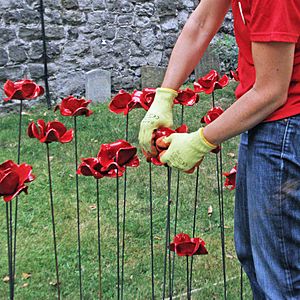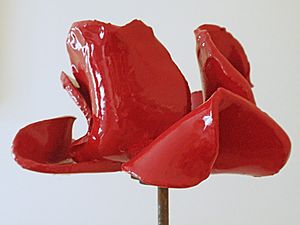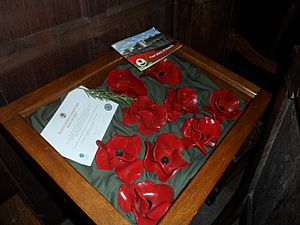Blood Swept Lands and Seas of Red facts for kids
Quick facts for kids Blood Swept Lands and Seas of Red |
|
|---|---|
| United Kingdom | |
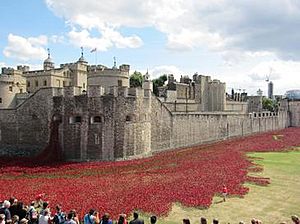 |
|
| For the centenary of the outbreak of World War I | |
| Established | 17 July 2014 |
| Unveiled | 11 November 2014 |
| Location | 51°30′33″N 0°04′31″W / 51.50912°N 0.07528°W moat at the Tower of London
|
| Designed by | Paul Cummins Tom Piper |
| Commemorated | 888,246 by ceramic poppies |
| Statistics source: Tower of London Remembers | |
Blood Swept Lands and Seas of Red was a huge art project. It was set up in the old moat of the Tower of London in England. This amazing display was there from July to November 2014.
The artwork was made to remember 100 years since World War I started. It featured 888,246 red ceramic poppies. Each poppy stood for one British or Colonial soldier who died in the war. The artist who made the poppies was Paul Cummins. The overall design was created by Tom Piper. The name of the artwork came from a poem written by an unknown soldier from World War I.
Contents
Why This Art Project Was Created
The idea for the artwork's name came from a poem. Artist Paul Cummins found this poem. It was written by a soldier from Derbyshire who joined the war early on. This soldier died during World War I.
The poem starts with the line: "The blood swept lands and seas of red, / Where angels dare to tread / ... ". Paul Cummins found the poem in the soldier's old will. This was among old papers in Chesterfield.
Paul Cummins Ceramics worked with Historic Royal Palaces to create the art. They chose the Tower of London's moat for the display. This moat was used as a training area for soldiers from the City of London at the start of the war. These soldiers were part of the "Stockbrokers' Battalion".
What the Poppy Display Looked Like
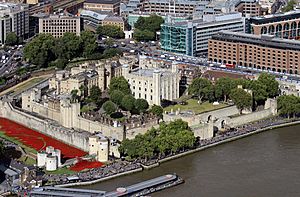
The artwork looked like a giant sea of red ceramic poppies. It seemed to pour out of the Tower itself and spread across the moat. Special parts of the design made the display even more dramatic.
One part was called "Weeping Window." It looked like poppies flowing out of a window in Legge's Mount. This became a very famous image. Another part, "Over the Top," showed poppies cascading down a wall. There was also the "Wave," a metal sculpture covered in poppies. It curled over the main path into the Tower.
The ceramic poppies were all made by hand. They were created at Cummins' workshop in Derbyshire and at Johnson Tiles in Tunstall. Volunteers helped to place each poppy into the display. In total, 888,246 poppies were used. This number represented the British and Colonial soldiers who died in World War I.
The first poppy was placed on July 17, 2014. The full artwork was shown on August 5. This was one day after Britain entered the war. About 17,500 volunteers helped put the poppies in place. They were guided by Tom Piper and Yeoman Warder Jim Duncan. This made it a true public art project.
The last poppy was placed on November 11, 2014. This day is Remembrance Day. A 13-year-old cadet named Harry Hayes placed it. After this, about 8,000 volunteers began removing the poppies. People could buy the ceramic poppies for £25 each. A large part of the money (over £15 million) went to six charities that help soldiers and their families.
Every evening from September 1 to November 10, something special happened. The names of 180 World War I soldiers were read aloud. These names were chosen by the public. A Yeoman Warder or a guest reader would read them. After the names, the Last Post bugle call was played.
Important Visitors and Public Opinion
Many important people visited the display. Prince William, Prince Harry, and the Duchess of Cambridge visited on the opening day. The Queen and Duke of Edinburgh visited on October 16. The Queen later talked about the memorial in her Christmas speech.
Around 5 million people saw the artwork. So many people wanted to see it that Prime Minister David Cameron and other politicians asked for the display to stay longer. However, Historic Royal Palaces and Paul Cummins said no. They felt that the artwork being temporary was an important part of its meaning. The poppies were removed as planned and sent to the people who bought them.
On November 8, it was announced that "Wave" would stay until the end of the month. Also, the "Wave" and "Weeping Window" sculptures would go on a tour around the UK. This tour was organized by 14–18 NOW. It lasted until November 2018, which was 100 years after the end of World War I. The sculptures visited 19 different places. After the tour, they became part of the Imperial War Museum's collection.
In April 2016, "Weeping Window" was set up at St Magnus Cathedral in Kirkwall, Orkney. This was to mark 100 years since the Battle of Jutland. This was the biggest naval battle of World War I.
Paul Cummins and Tom Piper were both given the MBE award. This was to recognize their amazing work on the poppy display.
What Critics Thought
Even though the public loved the display, some art critics had mixed feelings. A. A. Gill from The Sunday Times called it "impressive" but "curiously bland." The Guardian's art critic Jonathan Jones said it had a "false nobility." He also called it a "prettified and toothless" memorial.
Tom Piper responded by saying that it was good that the artwork was easy for everyone to understand. He believed art shouldn't always be difficult to get.
UK Tour of the Sculptures
In November 2014, it was announced that two parts of the installation, "Wave" and "Weeping Window," would travel around the UK. This tour lasted until 2018. It was organized by 14–18 NOW.
The "Weeping Window" Tour Locations
- Woodhorn Museum, Ashington, Northumberland (Sep 2015 – Nov 2015)
- St George's Hall, Liverpool (Nov 2015 – Jan 2016)
- St Magnus Cathedral, Kirkwall, Orkney (Apr 2016 – Jun 2016)
- Black Watch Museum, Perth (Jun 2016 – Sep 2016)
- Caernarfon Castle (Oct 2016 – Nov 2016)
- Hull Maritime Museum (Mar 2017 – May 2017)
- The Silk Mill, Derby (Jun 2017 – Jul 2017)
- Senedd, Cardiff (Aug 2017 – Sep 2017)
- Ulster Museum, Belfast (Oct 2017 – Dec 2017)
- Hereford Cathedral (Mar 2018 – Apr 2018)
- Carlisle Castle (May 2018 – Jul 2018)
- Middleport Pottery, Stoke-on-Trent (Aug 2018 – Sep 2018)
- Imperial War Museum, London (Oct 2018 – Nov 2018)
The "Wave" Tour Locations
- Yorkshire Sculpture Park (Sep 2015 – Jan 2016)
- Lincoln Castle (May 2016 – Sep 2016)
- Barge Pier, Shoeburyness (Apr 2017 – Jun 2017)
- Plymouth Naval Memorial (Aug 2017 – Nov 2017)
- Royal Armouries at Fort Nelson (Apr 2018 – Jun 2018)
- Imperial War Museum North, Manchester (Sep 2018 – Nov 2018)
After the tour ended, both "Wave" and "Weeping Window" became part of the Imperial War Museum's collection.
Remembering the End of the War
Another tribute, also designed by Tom Piper, was created in 2018. It was called Beyond the Deepening Shadow. For this, 10,000 flames were lit at the Tower of London. This marked 100 years since World War I ended. The flames were lit every night, ending on Armistice Day (November 11) 2018.
Images for kids
-
View of the Tower of London from The Shard, August 2014, with Blood Swept Lands and Seas of Red visible in the moat


